Binyat ar-Ramz al-Lugawiyyah fī at-Tafsīr aṣ-Ṣūfī
Abstract
Keywords
Full Text:
PDFReferences
إبراهيم، رجب عبد الجواد، دراسات في الدلالة والمعجم. القاهرة: مكتبة الخنجي، 1975.
الجوزية، ابن القيم. مدارج السالكين بين منازل إياك نعبد وإياك نستعين. القاهرة: مؤسسة المختار، ج.2، ط.1، 2010 .
القشيري، أبو القاسم. الرسالة القشيرية. بيروت: دار الكتب. العلمية، 2001.
الحسني، أحمد بن محمد بن عجيبة. إيقاظ الهمم في شرح الحكم. القاهرة: دار المعارف ، (د.ت).
الطوسي، الإمام. اللمع، تحقيق عبد الحليم محمود وطه عبد الباقي سرور. مصر: دار الكتب الحديثة، 1960.
الأمين، إحسان. منهج النقد في التفسير. بيروت: دار الهادي، 2007.
ربيع، محمود محمد. أسرار التأويل. مصر: الهيئة المصرية العامة، 1993.
السيوطي، جلال الدين. الإتقان في علوم القرآن. بيروت: مكتبة العصرية، 2009.
الشاطبي، أبو إسحاق بن إبراهيم بن موسى. الموافقات في أصول الشريعة. بيروت: دار الكتب العلمية، 2004.
الغزالي، أبو حامد. إحياء علوم الدين. بيروت: دار الحزم، 2005.
القونوي، صدر الدين. إعجاز البيان في تأويل أم القرآن. حيدر أبد: مجلس دائرة المعارف العثمانية، 1949.
المحاسبي، أبو عبد الله الحارث. العقل في فهم القرآن. بيروت: دار الفكر، 1971.
العزام، محمد مصطفى. الخطاب الصوفي بين التأول والتأويل. بيروت: مؤسسة الرحاب الحديثة، ط 1، 2010.
سليطين، وفيق. رمزية الناي في الشعر الصوفي. مجلة ثقافات، كلية الآداب، 2005.
Aminuddin (2015). Semantik. Bandung: Sinar Baru Algensindo.
Rashidi, Hadayat (2011). The Quranic Symbolism. International Journal of Current Research, 3(11), 264-269.
Khamid, A. (2020). Interpretasi Sufistik Atas Teks Al-Qur’an: Memahami Analisis Nadzari dan Isyari. Journal Al Irfani: Ilmu Al Qur’an Dan Tafsir, 1(02), 47–61. https://doi.org/10.51700/irfani.v1i02.65.
Meftah, Mohamed (2006). Dīnamiyyat an-naṣ. Casablanca: Al-Markaz al-Thaqāfī al-‘Arabī, 3rd ed.
Munir, Abdul. Penafsiran Imam al-Qusyairī> dalam Kitab Tafsir Lathāif al-Isyārāt. Disertasi, digilib uin jogja, 2009.
Pateda, Mansoer. Semantik Leksikal. Jakarta: Rineka Cipta, 2010.
Reflita & Syatri, Jonni (2020). Konstruksi Hermeneutika Tafsir sufi. Jurnal Studi Al Quran dan Hadis, 1(02), 169-198, DOI: 10.15548/mashdar.v2i2.1675.
Zamir, Syed Rizwan (2011). Tafsir al-Qur’an bi al-Qur’an: The Hermeneutics of Imitation and Adab in Ibn Arabi’s Interpretation of the Qur’an, Jurnal Islamic Studies, 50(1), 5-23.
Tabatabaee, mh. al-mizan fi tafsir al quran , Qom Iran: Islamic pub. Organization, vol 15 1996.
DOI: https://doi.org/10.18326/lisania.v6i2.235-254
Refbacks
- There are currently no refbacks.
Copyright (c) 2022 Muhammad Farid Abdullah

This work is licensed under a Creative Commons Attribution-ShareAlike 4.0 International License.
View My Stats








